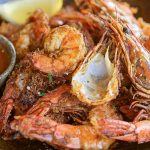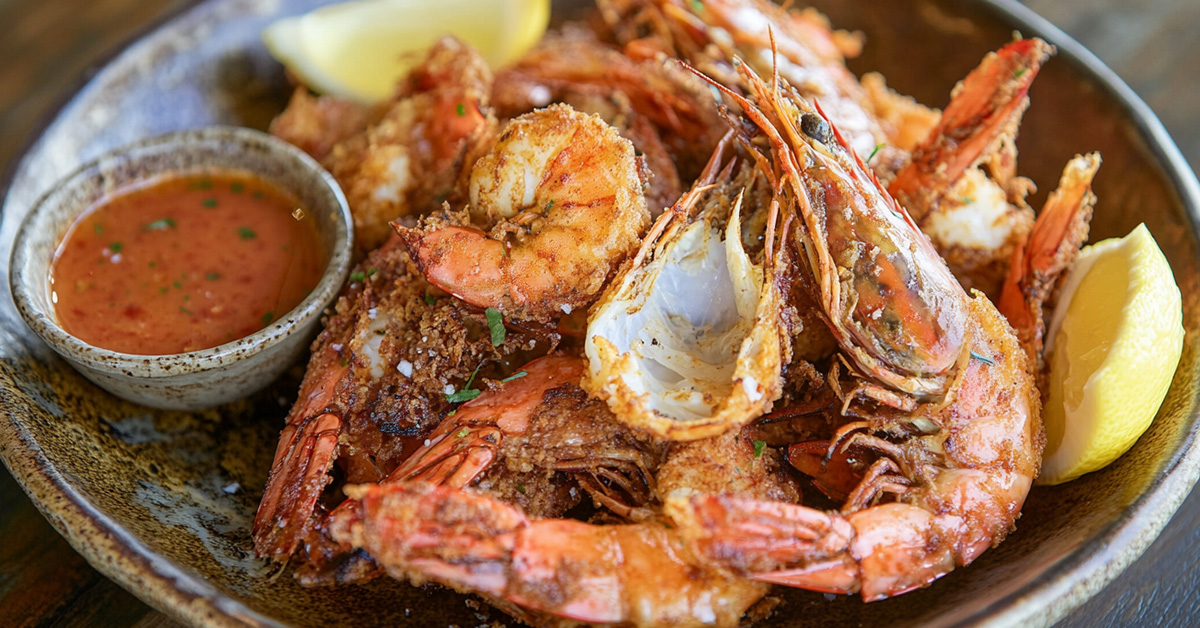Disclosure: As an Amazon Associate and participant in other affiliate programs, we earn from qualifying purchases. We only recommend products we believe will provide value to our readers.
Most home cooks throw away shrimp heads without realizing their true value – a staggering 75% of them end up in the trash. These discarded parts can reshape the scene of your cooking with their rich flavors and essential nutrients.
A proper shrimp head recipe will lift your cooking skills and reduce food waste. The possibilities range from a flavorful shrimp head stock to traditional dishes that showcase these overlooked ingredients.
This piece shows you how to create delicious meals from shrimp heads and understand their nutritional value while practicing green seafood habits. Professional chefs consider these ingredients precious, and you’ll find ways to boost your cooking with them.
Table of Contents
Understanding Shrimp Head Benefits
At the time you examine a shrimp head, it serves as a powerhouse of nutrition and flavor. A single serving of shrimp heads contains 18g of protein and just 1g of fat, which makes them perfect for your healthy diet. [Reference]
Nutritional value breakdown
Shrimp heads’ rich nutritional profile benefits your body significantly. They contain essential minerals like iron (3.60mg) and calcium (39.95mg) per serving. These heads are rich in polyunsaturated fatty acids and have an impressive omega-6 to omega-3 ratio ranging from 0.37 to 1.68. [Reference]
Health advantages
Shrimp heads are a great way to get remarkable health benefits:
- Rich in chitin that gets more and thus encourages more healthy gut bacteria growth.
- Contains astaxanthin, an antioxidant that helps prevent wrinkles and reduces sun damage.
- Provides cardiovascular protection through specific lipid compositions.
- Delivers essential amino acids, including glutamic acid (20.45mg).
Flavor enhancement properties
Shrimp heads create magic in your cooking. They contain special molecules called ribonucleotides that improve the savory umami flavor. These heads pack plenty of glutamic acid and other free amino acids that create that distinctive savory taste. The flavor compounds infuse into your dishes during cooking and create a depth of flavor impossible to achieve otherwise.
Shrimp heads in your cooking reduce waste and tap into a wealth of nutrition and flavor that can reshape the scene of your culinary creations.
Sustainable Seafood Practices
Sustainable seafood choices involve more than just knowing how to cook shrimp heads. Fish and shellfish that protect both species populations and ecosystems through responsible harvesting or farming methods are what we call sustainable seafood.
U.S. fisheries should be your first stop while buying shrimp because they follow strict management practices. These fisheries use specialized equipment like bycatch reduction devices and turtle excluder devices that protect non-target species. U.S. shrimp fisheries’ effect on the environment has decreased by a lot, thanks to regulations that have existed for decades.
Certification programs rate shrimp products based on their effect on the environment to help you make eco-friendly choices:
- Best Choice (Green): Well-managed and environmentally responsible.
- Good Alternative (Yellow): Moderate environmental impact.
- Avoid (Red): High environmental risk.
Your buying choices make a real difference – only 15.7% of global farmed shrimp production meets ASC, BAP, or Fair Trade certification standards right now. Ecuador leads the way in eco-friendly practices, and their shrimp industry has earned either certification or high ratings from Seafood Watch. [source]
State-of-the-art waste management practices are changing the industry. Shrimp shells and heads make up 50% of raw material and now serve as ingredients for various products. These materials transform into agricultural fertilizers and biodiesel catalysts. This approach creates value from previously discarded materials and reduces harm to the environment.
Note that picking sustainably sourced shrimp helps protect our environment and keeps the seafood industry viable for years to come. Certification labels and U.S.-caught options should top your shopping list.

Shrimp Head Recipe
- Total Time: 30 minutes
Description
Don’t throw away those shrimp heads! You can make them into a delicious crispy treat that’s both eco-friendly and flavorful. These crunchy delicacies are popular in many Asian cuisines.
The perfectly crispy fried shrimp heads give you an amazing mix of textures – crunchy outside with a rich, flavorful inside.
Ingredients
- 24 medium shrimp heads, cleaned.
- 1 cup cornstarch.
- 1/2 cup all-purpose flour.
- 1/2 cup cake flour.
- 1 1/2 tablespoons kosher salt.
- 1 tablespoon baking powder.
- 4 cups canola or frying oil.
Instructions
- Clean the shrimp heads with water and 1/2 teaspoon of turmeric.
- Remove the feelers and pat the heads dry completely.
- Mix your dry ingredients in a bowl until well combined.
- Heat oil to 350°F (175°C) in a large saucepan.
- Coat shrimp heads lightly with the flour mixture.
- Fry in small batches for 1-2 minutes until golden brown.
- Remove and drain on paper towels.
Notes
- Your oil temperature plays a vital role – if it smokes, it’s too hot.
- Start with one head as a test run to perfect your timing.
- Serve within 30 minutes to get the best texture.
- You can eat all but one part of the head – skip the purple sack behind the “nose”.
- Prep Time: 15 minutes
- Cook Time: 15 minutes
- Category: Fried
- Method: Frying
Global Culinary Traditions
Shrimp heads play a special role in culinary traditions worldwide. Spain turns them into flavorful tapas, while Mexico uses them as the base for rich broths passed down through generations.
Seafood lovers know the value of using every part of the catch. Many food cultures treasure shrimp heads for their powerful flavors. People often savor the juices straight from prawn heads – a treat that packs an intense ocean flavor punch.
Here’s how different cultures celebrate shrimp heads:
- Mexico: Camarones enchipotlados featuring whole shrimp in chipotle sauce.
- Greece: Garides saganaki with shrimp heads adding depth to the tomato sauce.
- India: Chingri Malai curry where heads boost the curry’s richness.
- Spain: Gambas al ajillo showcasing head-on shrimp in garlic sauce.
Shrimp heads show their versatility across global cuisines. Southern Nigerian cooks blend them into thick, chowder-like soups. Malaysian street vendors create their famous prawn noodle soup with these flavorful bits. These methods honor old traditions and support eco-friendly cooking, since shrimp heads make up more than 50% of the animal. [Reference]
Today’s chefs draw inspiration from these time-tested methods and create innovative dishes. Shrimp heads now appear as savory seasonings that add their rich umami taste to pasta dishes and stir-fries.
Read also: Amberjack Recipe
Shrimp Head Recipe – From Kitchen to Table
The journey from kitchen to table needs attention to detail and presentation skills. Good plating can raise your shrimp head creation from a simple meal to a restaurant-worthy dish.
Presentation tips
A visually appealing plate should follow the rule of thirds. Place your main seafood element slightly off-center and experiment with accompaniment positions. Here are vital plating elements to think about:
- Pick contrasting plate colors that make the dish stand out.
- Stack components with care to add height.
- Keep the plate rims spotless without crowding.
- Add fresh herbs to boost color and aroma.
Serving suggestions
Temperature plays a significant role in creating the perfect shrimp head experience. Hot dishes should go straight from stove to table to keep their best texture and flavor. White or neutral-colored plates let your dish’s natural colors shine. Garnishes should have a purpose – fresh herbs, edible flowers, and citrus zest can boost your dish’s appeal without taking over.
Pairing recommendations
The right wine can make your dish even better. Here are some wine selections based on how you cook it:
- Light, Crisp Whites: Sauvignon Blanc or Pinot Grigio offer citrus and herbaceous notes.
- Sparkling Wines: Prosecco or Cava work well with lighter preparations.
- Regional Wines: Local wines highlight regional flavors, especially in dishes with unique seasonings.
Your meal becomes complete with sides like corn on the cob, rice, or asparagus. These sides should complement your main dish rather than compete with it.
Read also: Fried Dover Sole Recipe
Conclusion
Shrimp heads offer a perfect combination of culinary wisdom and environmentally responsible cooking. These underutilized ingredients deliver impressive nutritional benefits and add deep, rich flavors to dishes. Their versatility emerges through countless global recipes that prove their worth beyond making simple stock.
Cooking with shrimp heads strengthens both environmental conservation and traditional cooking methods. You participate in a centuries-old culinary tradition and reduce food waste when you turn these ingredients into crispy appetizers or rich broths.
Successful shrimp head preparation depends on proper technique and attention to detail. The process begins with environmentally sourced seafood. You can explore cooking methods that appeal to you and present your creations with appropriate care. The rich flavors will make you question why anyone would discard these culinary treasures.













